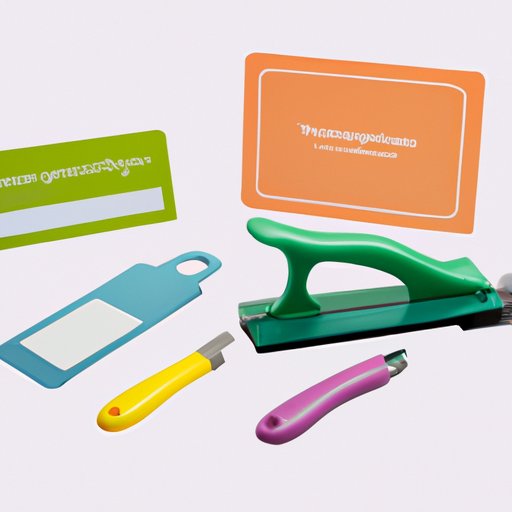
I. Introduction
Printing labels is an essential task that everyone needs to know how to do in today’s world, especially in homes, offices, and businesses.
It can help individuals and organizations to create customized labels for packaging, branding, organizing, shipping, and many other purposes quickly and efficiently.
Whether it’s for business or personal use, knowing how to print labels properly can give you an edge to stand out and save time, money, and energy. In this guide, we’ll share with you some step-by-step tips on how to print labels, creative ideas to design your labels, the right labels and printers to use, how to troubleshoot common printing problems, and optimization tips that can help you streamline the process.
II. Step-by-Step Guide
To start printing labels, you first need to set up your printer, load your label sheets, and select the label type. Here are some simple steps to guide you:
- Ensure that your printer is set up correctly. Follow the manufacturer’s instructions on how to connect the printer to your computer or device and install the necessary drivers and software.
- Load the label sheets into your printer’s paper tray or manual feed. Make sure that the label sheet’s size is compatible with your printer’s specifications.
- Choose the right label type and template according to your needs. You can use basic label templates that come with your printer’s software or create your own customized templates using label-making software.
- Enter the necessary text, graphics, or images that you want to include on your labels. Be creative and concise in your designs and use contrasting colors to make them stand out.
- Select the printer’s settings, such as the type of material you’re printing on, print quality, and layout. Preview your design before printing to check for any errors or adjustments you need to make.
- Click on the Print button and wait for the labels to print. Once they’re done, remove them carefully from the printer’s tray, and you’re ready to use them.
It’s important to note that label printing can vary depending on your printer’s model and the software you’re using. Always refer to the manual or online guides for specific instructions.
III. Creative Labels
While basic text labels are functional, creating unique and creative labels can help grab your audience’s attention. Adding images, graphics, and barcodes or QR codes can make your labels stand out. Here are some creative label designs you can try:
- Use high-quality images or illustrations to create product labels that capture your product’s essence and make them look more appealing.
- Consider using barcodes or QR codes on your labels to make inventory and item tracking easier and more efficient.
- Combine different font sizes and styles to make key information like brand names, addresses, and dates, more prominently displayed.
- Try adding color coding and symbols to organize your products and make them easier to find or recognize.
- Experiment with different label shapes and sizes to make your products look more unique.
IV. The Right Labels and Printers
To ensure that you’re using the right labels and printers for your specific needs, here are some things to consider:
- Choose a printer that’s compatible with your label’s size and type. Some printers have built-in label printing features that can save you money and time in the long run.
- Select the right label material for your intended use. For instance, thermal labels work well for shipping and inventory purposes, while waterproof labels work well for outdoor and long-lasting use.
- Ensure that the adhesive on your label matches the surface that it will be applied to. For example, labels with strong adhesives are better for rough or corrugated surfaces.
- Consider investing in a label printer that can handle a high volume of labels, save you money on ink or toner, and increase your productivity.
- Check if the label supplier offers custom-made labels according to your specifications. This way, you can have control over design, paper stock, and adhesive selection.
V. Troubleshooting Guide
Even with a well-functioning printer and label materials, some issues may still arise during the printing process. Here are some common printing problems and their solutions:
- Alignment errors – If your printed labels appear out of alignment, double-check your printer’s paper setting and adjust them accordingly.
- Jamming – If the labels get stuck or jammed inside the printer, open the printer’s cover, and remove the jammed paper carefully. Restart your printer and re-attempt to print the labels.
- Print quality – If the labels come out with smudges, streaks, or appear too light or too dark, check if your ink cartridge or toner is running low or if the printer heads need cleaning. Replace the cartridges if they’re empty or clean the printer heads using the printer’s tool.
VI. Optimization Tips
If you’re printing labels frequently, you may want to optimize and speed up the process by:
- Using label-making software or tools that can create and save customized templates for future use.
- Creating a label printing workflow that centralizes the printing process and avoids confusion and delays.
- Investing in label printing hardware or applications that can automate and streamline the printing process, such as label printers with automatic label cutters and label applicators.
VII. Conclusion
Printing labels can be a vital task in everyday life, but it doesn’t have to be challenging or time-consuming.
By following our step-by-step tips, being creative with your designs, using the right printers and label materials, learning how to troubleshoot any issues that arise, and optimizing the process to suit your specific needs, you can make label printing a breeze.
Therefore, don’t shy away from experimenting with new label designs or processes to make your labels more visually appealing and functional. It’s a skill that can take your brand or personal productivity to the next level.





